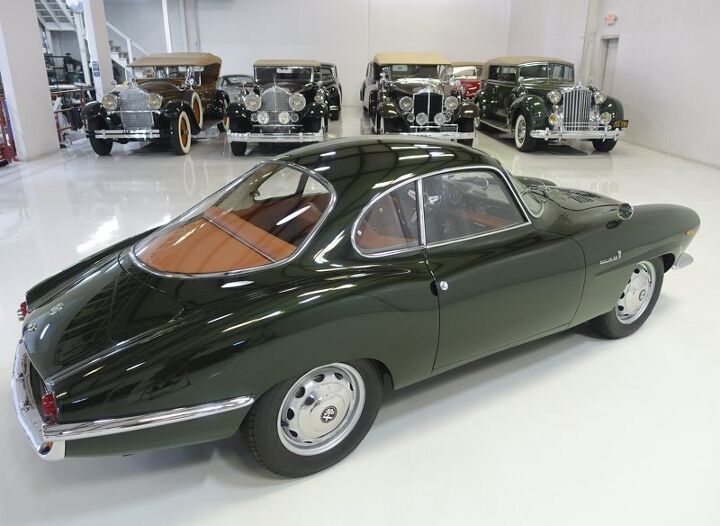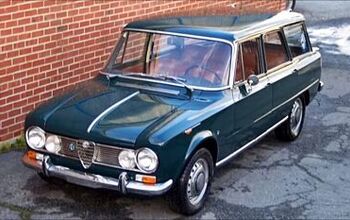Rare Rides: A 1964 Alfa Romeo Giulia Sprint Speciale

Though Rare Rides featured five Alfa Romeos previously, four of them coupes, none were quite as shapely and stylish as today’s teardrop-shaped subject. It’s a beautiful emerald green Giulia Sprint Speciale from 1964.
This very special coupe had its foundations in the much more pedestrian, mass-market Giulietta, which entered production in 1954. The company’s small family car offering in the Fifties, it was available in sedan, four-place coupe, and roadster varieties. Giulietta’s design heritage was all over the map, with Zagato, Pininfarina, and Bertone all contributing their designs. Production took place in three places in Italy (and also South Africa for some export market versions).
Franco Scaglione of Bertone was tabbed to design the standard Giulietta coupe, which was called Sprint. Turning up the wick later, Scaglione worked up a much sexier shape for the very special Sprint Speciale. Said design was shown for the first time at the Turin Motor Show in 1957, three years after the standard Sprint entered production. In prototype format the car had no bumpers, and was generally minimal in its appearance; Alfa Romeo built three more prototypes before debuting the production-ready version at Monza in summer 1959.
Intended as a racing competitor, the first 101 cars produced were regulation specials. Known as 750 SS, they were homologation units required by the FIA. Some were made entirely of aluminum, but most were steel-bodied with aluminum doors, trunk, and hood. Their noses were low, and they remained without bumpers like the concept. There was a purpose to the smooth minimalism, however: the reduction of drag. With a drag coefficient of .28, it was as slippery as a Corvette from 2010.
After the homologation run, full production began on the Sprint Speciale. Doors became steel, bumpers appeared, revised carburetors were fitted, and windows were glass instead of plastic. Alfa also added some sound insulation to coddle the more delicate customer. Initially the engine and transmission were the same 1.3-liter (100 hp)/five-speed manual combination used in the racing cars. After just 1,366 Giulietta SS models were made, the coupe changed identities.
Alfa Romeo fitted a larger engine — a 1.6-liter inline-four (112 hp), changed the brakes from drums to discs at the front, and slightly revised the dashboard. Given this “new” car was more grown up than its older sibling, the name changed to Giulia Sprint Speciale. It was an odd choice, as at its debut in Geneva in 1963 the actual Giulia had been in production for a year. Alfa Romeo even had a Giulia SS prototype made; they just decided not to use it. The new Giulietta-called-Giulia coupe remained in production through 1965, and a total of 1,400 larger engine examples were completed.
In restored condition and with perfect Verde Scuro Metallizzato paint, Giulia is offered at $139,900.
[Images: seller]

Interested in lots of cars and their various historical contexts. Started writing articles for TTAC in late 2016, when my first posts were QOTDs. From there I started a few new series like Rare Rides, Buy/Drive/Burn, Abandoned History, and most recently Rare Rides Icons. Operating from a home base in Cincinnati, Ohio, a relative auto journalist dead zone. Many of my articles are prompted by something I'll see on social media that sparks my interest and causes me to research. Finding articles and information from the early days of the internet and beyond that covers the little details lost to time: trim packages, color and wheel choices, interior fabrics. Beyond those, I'm fascinated by automotive industry experiments, both failures and successes. Lately I've taken an interest in AI, and generating "what if" type images for car models long dead. Reincarnating a modern Toyota Paseo, Lincoln Mark IX, or Isuzu Trooper through a text prompt is fun. Fun to post them on Twitter too, and watch people overreact. To that end, the social media I use most is Twitter, @CoreyLewis86. I also contribute pieces for Forbes Wheels and Forbes Home.
More by Corey Lewis
Latest Car Reviews
Read moreLatest Product Reviews
Read moreRecent Comments
- Dwford Will we ever actually have autonomous vehicles? Right now we have limited consumer grade systems that require constant human attention, or we have commercial grade systems that still rely on remote operators and teams of chase vehicles. Aside from Tesla's FSD, all these systems work only in certain cities or highway routes. A common problem still remains: the system's ability to see and react correctly to obstacles. Until that is solved, count me out. Yes, I could also react incorrectly, but at least the is me taking my fate into my own hands, instead of me screaming in terror as the autonomous vehicles rams me into a parked semi
- Sayahh I do not know how my car will respond to the trolley problem, but I will be held liable whatever it chooses to do or not do. When technology has reached Star Trek's Data's level of intelligence, I will trust it, so long as it has a moral/ethic/empathy chip/subroutine; I would not trust his brother Lore driving/controlling my car. Until then, I will drive it myself until I no longer can, at which time I will call a friend, a cab or a ride-share service.
- Daniel J Cx-5 lol. It's why we have one. I love hybrids but the engine in the RAV4 is just loud and obnoxious when it fires up.
- Oberkanone CX-5 diesel.
- Oberkanone Autonomous cars are afraid of us.








































Comments
Join the conversation
Were the interiors as well-detailed on these things from the factory? These restored examples we've seen here seem too good to be true, but maybe the Italians were just that far ahead?
Hello scaglione penned the giulietta sprint while wirking at bertone, not zagato as posted. Best regards